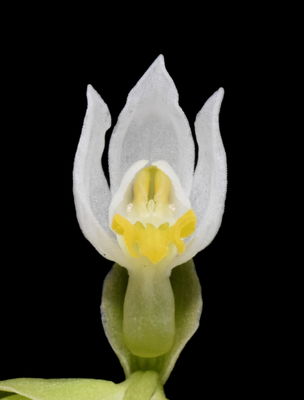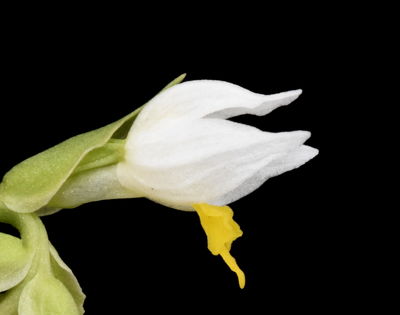-
Distribution
-
Schizochilus comprises 11 species in the summer-rainfall region in southern and south-central Africa as far north as southern Tanzania. (PL, HK).
-
General Description
-
Slender terrestrial herbs with testicular tubers and a few unbranched roots. Stem to 80 cm tall, glabrous, green, erect. Leaves basal and/or cauline, linear to rarely elliptic, narrowly oblanceolate or ovate, acute, glabrous; lower leaves 5-30, usually semi-erect with a prominent midrib; cauline leaves smaller, above grading into the floral bracts. Inflorescence terminal, sparse to dense, usually nodding; bracts green, acuminate, ovate to narrowly lanceolate, generally as long as the ovaries. Flowers non-resupinate, 1.5-10 mm in diameter, white, white and yellow, yellow, or white with a mauve or pink tint. Dorsal sepal narrowly to broadly elliptic or elliptic-oblong to round, often apiculate, shallowly galeate. Lateral sepals suboblique, lanceolate to ovate, more or less acute, slightly larger than the dorsal sepal. Petals a a 1/3-2/3 as long as the sepals, single-veined, oblique, usually more or less rhomboid and acute, free from the lip and column. Labellum as long as the sepals, the epichile more or less three-lobed with the central lobe longer than the lateral lobes; hypochile concave, leading into the spur, frequently with calli between the hypochile and epichile; spur cylindrical to bifid, slender to clavate, always shorter than the lip, generally straight. Column erect, slender; anther thecae erect or angled to 45°, parallel and adjacent; lateral appendages small; pollinia sectile, with short caudicles and two small naked viscidia; stigma flat, above the entrance to the spur; rostellum three-lobed with small central lobe, lateral lobes square, carrying the viscidia. (PL, HK).
-
Ecology
-
The typical habitat of Schizochillus is damp montane grassland where it often grows in shallow soils and in moss seepages over rocks, usually at elevations ranging from 1500 to 3000 m. Localities for the genus include the high-rainfall areas of eastern South Africa, but some species have also been recorded at much lower elevations on the Transkei coast (Sc helpe 1966). Schizocbillls perennates by means of tubers and usually flowers in the spring or summer, often appearin g after fire. Populations of the dimorphic species, S. cecilii Rolfe, are unusual in that they may in clude both white and yellow flower colour forms (la Croix and Cribb 1995). In a recent survey for the IUCN (IUCN Orchid Specialist Group 1996) P. Linder cited potential affore ration of montane and mid-elevation grasslands as a principal risk to survival of some Schizochilus species such as the endemic S. gerrardii (Rchb.f) Bolus, which is, restricted to one area of grassland in northern Natal (Linder 1980). Witbin the range of the genus, some taxa have restricted distributions. Schizochilus cecilii subsp. cecilii is known only from the area of Nyanga in Zimbabwe, and S. calcaratus Cribb & la Croix is found only in the Chimanimani Mountains. Other species are more widespread, such as S. sulphureus, which occurs in mountains and plateaus in Malawi and Mozambique and the southern highlands of Tanzania (la Croix and Cribb 1995). (RN.)






